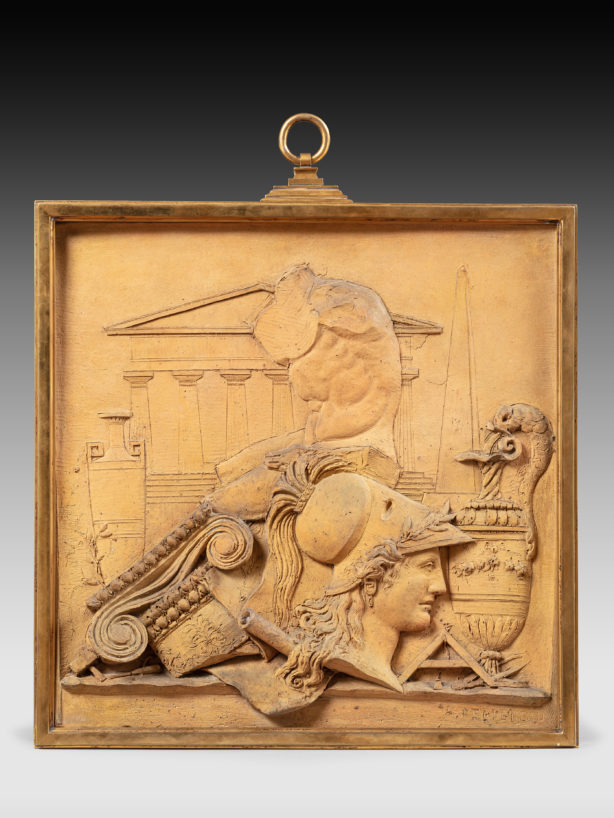Allegory of the fine arts by A. Perdereau (circa 1760-circa 1820)
An invitation to reverie, this terracotta relief is a tribute to fine art and classical culture. An effigy of Athena / helmeted Minerva stands next to an Ionic capital, a ewer rises next to an obelisk, the Belvedere Torso dominates the scene, and an antique amphora rises in front of a Greek temple modeled after those in Paestum. This triangular composition, enclosed like a stage curtain by the building, invites the eye to linger on each object.
A thousand details dot this three-dimensional painting: scrolls in the foreground, an architect’s square and compass, a sculptor’s chisel, a scroll winding around the amphora, a laurel wreath on Minerva’s helmet, a garland on the ewer.
The Belvedere Torso, a true bravura piece, is finely carved in a flat pattern, and perfectly conveys the impression of three dimensions. The attention to detail and the shimmering modelling of the ewer and the capital deliberately contrast with the sacred severity of the temple in the background, accentuating the decorative power of the representation.
This homage to ancient Rome draws on the many engravings that had been circulating since the 16th century, but also suggests a journey. The frenzy that gripped the province since the discovery of Herculaneum in 1738 and Pompeii ten years later, attracted artists, collectors and scholars from all over Europe, making Rome a cosmopolitan city, where ancient ruins juxtaposed with the most sumptuous Baroque achievements and the modernity of a Canova.
Beyond its decorative aspect, like a painting modelled in terracotta, this work can be read as an aesthetic statement. The reverence for Egyptian and Greco-Roman antiquity, which Neoclassicism sets as an absolute and unsurpassable model, closes the background and dominates the composition. The line, however, is finer, almost graceful, and fades in a perspective effect in favor of the foreground occupied by contemporary creations. The ewer is in the Louis XVI style, the beautifully shaped Minerva is typical of 18th-century sculpture, and the elaborate capital breaks all the rules of antiquity. The modern artist sees himself as the heir to the Ancients, from whom he draws inspiration to create a new style. A symbol of the new century’s admiring rivalry with Antiquity, this relief also echoes a new artistic Golden Age.




